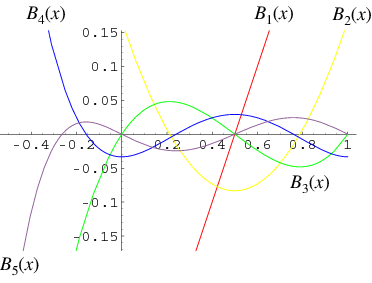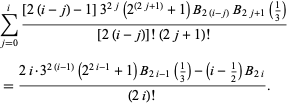

تاريخ الرياضيات

الاعداد و نظريتها

تاريخ التحليل

تار يخ الجبر

الهندسة و التبلوجي


الرياضيات في الحضارات المختلفة

العربية

اليونانية

البابلية

الصينية

المايا

المصرية

الهندية


الرياضيات المتقطعة

المنطق

اسس الرياضيات

فلسفة الرياضيات

مواضيع عامة في المنطق


الجبر

الجبر الخطي

الجبر المجرد

الجبر البولياني

مواضيع عامة في الجبر

الضبابية

نظرية المجموعات

نظرية الزمر

نظرية الحلقات والحقول

نظرية الاعداد

نظرية الفئات

حساب المتجهات

المتتاليات-المتسلسلات

المصفوفات و نظريتها

المثلثات


الهندسة

الهندسة المستوية

الهندسة غير المستوية

مواضيع عامة في الهندسة

التفاضل و التكامل


المعادلات التفاضلية و التكاملية

معادلات تفاضلية

معادلات تكاملية

مواضيع عامة في المعادلات


التحليل

التحليل العددي

التحليل العقدي

التحليل الدالي

مواضيع عامة في التحليل

التحليل الحقيقي

التبلوجيا

نظرية الالعاب

الاحتمالات و الاحصاء

نظرية التحكم

بحوث العمليات

نظرية الكم

الشفرات

الرياضيات التطبيقية

نظريات ومبرهنات


علماء الرياضيات

500AD

500-1499

1000to1499

1500to1599

1600to1649

1650to1699

1700to1749

1750to1779

1780to1799

1800to1819

1820to1829

1830to1839

1840to1849

1850to1859

1860to1864

1865to1869

1870to1874

1875to1879

1880to1884

1885to1889

1890to1894

1895to1899

1900to1904

1905to1909

1910to1914

1915to1919

1920to1924

1925to1929

1930to1939

1940to the present

علماء الرياضيات

الرياضيات في العلوم الاخرى

بحوث و اطاريح جامعية

هل تعلم

طرائق التدريس

الرياضيات العامة

نظرية البيان
Bernoulli Polynomial
المؤلف:
Abramowitz, M. and Stegun, I. A.
المصدر:
"Bernoulli and Euler Polynomials and the Euler-Maclaurin Formula." §23.1 in Handbook of Mathematical Functions with Formulas, Graphs, and Mathematical Tables, 9th printing. New York: Dover
الجزء والصفحة:
...
15-9-2019
2340
Bernoulli Polynomial

There are two definitions of Bernoulli polynomials in use. The  th Bernoulli polynomial is denoted here by
th Bernoulli polynomial is denoted here by  (Abramowitz and Stegun 1972), and the archaic form of the Bernoulli polynomial by
(Abramowitz and Stegun 1972), and the archaic form of the Bernoulli polynomial by  (or sometimes
(or sometimes  ). When evaluated at zero, these definitions correspond to the Bernoulli numbers,
). When evaluated at zero, these definitions correspond to the Bernoulli numbers,
 |
 |
 |
(1) |
 |
 |
 |
(2) |
The Bernoulli polynomials are an Appell sequence with
 |
(3) |
(Roman 1984, p. 31), giving the generating function
 |
(4) |
(Abramowitz and Stegun 1972, p. 804), first obtained by Euler (1738). The first few Bernoulli polynomials are
 |
 |
 |
(5) |
 |
 |
 |
(6) |
 |
 |
 |
(7) |
 |
 |
 |
(8) |
 |
 |
 |
(9) |
 |
 |
 |
(10) |
 |
 |
 |
(11) |
Whittaker and Watson (1990, p. 126) define an older type of "Bernoulli polynomial" by writing
 |
(12) |
instead of (12). This gives the polynomials
 |
(13) |
where  is a Bernoulli number, the first few of which are
is a Bernoulli number, the first few of which are
 |
 |
 |
(14) |
 |
 |
 |
(15) |
 |
 |
 |
(16) |
 |
 |
 |
(17) |
 |
 |
 |
(18) |
The Bernoulli polynomials also satisfy
 |
(19) |
and
 |
(20) |
(Lehmer 1988). For  ,
,
 |
(21) |
so
 |
(22) |
for odd  .
.
They also satisfy the relation
 |
(23) |
(Whittaker and Watson 1990, p. 127).
For rational values of  ,
,  can be expressed for positive integers
can be expressed for positive integers  in terms of Bernoulli and Euler numbers, for example
in terms of Bernoulli and Euler numbers, for example
 |
 |
 |
(24) |
 |
 |
 |
(25) |
 |
 |
 |
(26) |
 |
 |
 |
(27) |
 |
 |
 |
(28) |
Bernoulli (1713) defined the polynomials in terms of sums of the powers of consecutive integers,
![sum_(k=0)^(m-1)k^(n-1)=1/n[B_n(m)-B_n(0)].](http://mathworld.wolfram.com/images/equations/BernoulliPolynomial/NumberedEquation10.gif) |
(29) |
The Bernoulli polynomials satisfy the recurrence relation
 |
(30) |
(Appell 1882), and obey the identity
 |
(31) |
where  is interpreted as the Bernoulli number
is interpreted as the Bernoulli number  . Another related identity is
. Another related identity is
 |
(32) |
where  is interpreted as the Bernoulli polynomial
is interpreted as the Bernoulli polynomial  .
.
Hurwitz gave the Fourier series
 |
(33) |
for  , where the prime in the summation indicates that the term
, where the prime in the summation indicates that the term  is omitted. Performing the sum gives
is omitted. Performing the sum gives
 |
(34) |
where  is the polylogarithm function. Raabe (1851) found
is the polylogarithm function. Raabe (1851) found
 |
(35) |
A sum identity involving the Bernoulli polynomials is
 |
(36) |
for  an integer. A sum identity due to S. M. Ruiz is
an integer. A sum identity due to S. M. Ruiz is
 |
(37) |
where  is a binomial coefficient. The Bernoulli polynomials are also given by the formula
is a binomial coefficient. The Bernoulli polynomials are also given by the formula
 |
(38) |
where  is a Stirling number of the second kind and
is a Stirling number of the second kind and  is a falling factorial (Roman 1984, p. 94). A general identity is given by
is a falling factorial (Roman 1984, p. 94). A general identity is given by
 |
(39) |
which simplifies to
 |
(40) |
(Roman 1984, p. 97). Gosper gave the identity
 |
(41) |
A generalization  of the Bernoulli polynomials with an additional free parameter can be defined such that
of the Bernoulli polynomials with an additional free parameter can be defined such that  (Roman 1984, p. 93). These polynomials have the generating function
(Roman 1984, p. 93). These polynomials have the generating function
 |
(42) |
and are implemented in the Wolfram Language as NorlundB[n, alpha, z].
REFERENCES:
Abramowitz, M. and Stegun, I. A. (Eds.). "Bernoulli and Euler Polynomials and the Euler-Maclaurin Formula." §23.1 in Handbook of Mathematical Functions with Formulas, Graphs, and Mathematical Tables, 9th printing. New York: Dover, pp. 804-806, 1972.
Appell, P. E. "Sur une classe de polynomes." Annales d'École Normal Superieur, Ser. 2 9, 119-144, 1882.
Arfken, G. Mathematical Methods for Physicists, 3rd ed. Orlando, FL: Academic Press, p. 330, 1985.
Bernoulli, J. Ars conjectandi. Basel, Switzerland, p. 97, 1713. Published posthumously.
Euler, L. "Methodus generalis summandi progressiones." Comment. Acad. Sci. Petropol. 6, 68-97, 1738.
Lehmer, D. H. "A New Approach to Bernoulli Polynomials." Amer. Math. Monthly. 95, 905-911, 1988.
Lucas, E. Ch. 14 in Théorie des Nombres. Paris, 1891.
Prudnikov, A. P.; Marichev, O. I.; and Brychkov, Yu. A. "The Generalized Zeta Function  , Bernoulli Polynomials
, Bernoulli Polynomials  , Euler Polynomials
, Euler Polynomials  , and Polylogarithms
, and Polylogarithms  ." §1.2 in Integrals and Series, Vol. 3: More Special Functions. Newark, NJ: Gordon and Breach, pp. 23-24, 1990.
." §1.2 in Integrals and Series, Vol. 3: More Special Functions. Newark, NJ: Gordon and Breach, pp. 23-24, 1990.
Raabe, J. L. "Zurückführung einiger Summen und bestimmten Integrale auf die Jakob Bernoullische Function." J. reine angew. Math. 42, 348-376, 1851.
Roman, S. "The Bernoulli Polynomials." §4.2.2 in The Umbral Calculus. New York: Academic Press, pp. 93-100, 1984.
Spanier, J. and Oldham, K. B. "The Bernoulli Polynomial  ." Ch. 19 in An Atlas of Functions. Washington, DC: Hemisphere, pp. 167-173, 1987.
." Ch. 19 in An Atlas of Functions. Washington, DC: Hemisphere, pp. 167-173, 1987.
Whittaker, E. T. and Watson, G. N. A Course in Modern Analysis, 4th ed. Cambridge, England: Cambridge University Press, 1990.
 الاكثر قراءة في التفاضل و التكامل
الاكثر قراءة في التفاضل و التكامل
 اخر الاخبار
اخر الاخبار
اخبار العتبة العباسية المقدسة

الآخبار الصحية















 قسم الشؤون الفكرية يصدر كتاباً يوثق تاريخ السدانة في العتبة العباسية المقدسة
قسم الشؤون الفكرية يصدر كتاباً يوثق تاريخ السدانة في العتبة العباسية المقدسة "المهمة".. إصدار قصصي يوثّق القصص الفائزة في مسابقة فتوى الدفاع المقدسة للقصة القصيرة
"المهمة".. إصدار قصصي يوثّق القصص الفائزة في مسابقة فتوى الدفاع المقدسة للقصة القصيرة (نوافذ).. إصدار أدبي يوثق القصص الفائزة في مسابقة الإمام العسكري (عليه السلام)
(نوافذ).. إصدار أدبي يوثق القصص الفائزة في مسابقة الإمام العسكري (عليه السلام)


















